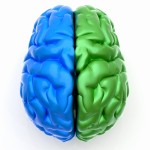Article supports the Whole Brain approach of ImaginationGYM Method
Revisiting the Left/Right-Brain Dialogue
Many faculty and staff will talk about using your right or left brain for particular tasks. Even some learning styles authors may reference you to these functions. Want to understand more about how your brain functions? The following short article by Eric Jensen may help: Is there more to our brain than the simple left-side, right-side split? Yes. Even though it is this lateral dichotomy we hear about the most, the energy in our brain moves up and down on a vertical axis – from the brain stem to the cortex and back down again – as well. Our brain is designed to process spatially from left to right hemisphere, but we process time (past to future) from back to front, and neuropeptides circulating through the blood also influence our thinking, behaviors, and reactions. Our brain is, indeed, a micro-universe.
Contrary to what some would lead you to believe, there is no such thing as right-brain learning or left-brain learning. There are only preferences where more of one hemisphere is activated than another. There is no learning taking place only in the upper cortex or only in the brain stem. Our brain is highly interactive. Much of the original work of Nobel Prize Laureate Roger Sperry, PhD, who discovered the functioning differences between left- and right-brain hemispheres, remains valid today. The challenge, however, has been keeping the finding in perspective. Some have oversimplified the conclusions or taken them to an extreme, creating a split in thinking that is unwarranted by the literature. Some books even appeared that draw up battle lines over the “old left-brain way” and the “updated right-brain approach.” It is an oversimplification to say that an individual is left brained or right brained. We are all whole brained.
Each area of the brain senses what is needed and interacts with other areas in a symbiotic micro-second. What we can safely say about each brain hemisphere is this: The left hemisphere processes “parts” (sequentially) The right side processes “wholes” (randomly) Follow-up research by Jerry Levy, PhD, (1983, 1985) of the University of Chicago has confirmed that both sides of the brain are involved in nearly every human activity, and timing and degree of involvement are important factors. Events occurring in one hemisphere can influence developmental events occurring at the same time at very remote parts of the other hemisphere. It is best to consider brain-side specificity in a more metaphorical sense. It may help us understand how we process information, but to pigeon-hole all behaviors into a blueprint of right or left hemispheric behaviors leads to faulty interpretations.
Here’s an example of how complex brain-side specificity can be. Listening to someone speak may seem like a left-hemisphere activity since the left side process words, definitions, and language.Contrary to this, however, evidence suggests that the right hemisphere process the inflection, tonality, tempo, and volume of the communication – elements that are actually more critical to the meaning of a conversation than the words themselves. Further, the female brain processes both language and feelings at the same time far more efficiently than the male brain. Thus, gender may be a factor as well. James Iaccino, PhD, (1993) suggests that although each hemisphere does have some clear-cut specialization, each side “still requires the other to complement its overall functioning.” . . .
Left-brain dominant learners, most often than not, may:
Prefer things in sequence
Learn best from parts to wholes
Prefer a phonetic reading system
Like words, symbols, and letters
Rather read about a subject first
Want to gather related factual information
Prefer detailed orderly instructions
Experience more internal focus
Want structure and predictability
Right-brain dominant learners, more often than not, may:
Be more comfortable with randomness
Learn best from wholes to parts
Prefer a whole-language reading system
Like pictures, graphs, and charts
Rather see or experience a subject first
Want to gather information about relationships among things
Prefer spontaneous, go-with-the-flow learning environments
Experience more external focus
Want open-ended approaches, novelty, and surprises
The Paradox of Left-Brain Creativity
The notion that one side of the brain is logical and the other side is creative is outdated. We can become very creative by following and using logical sequences, patterns, and variations.The work of Edward DeBono on lateral thinking (1970) reminds us that one can use “left-brain systems” to be creative. For years he has articulated processes to arrive at creative solutions through sequential methods. Is music a right-brain experience? Think again! Researchers discovered that musicians process music to a greater degree in t he left hemisphere, while non-musicians process it more in the right hemisphere. This paradox points to the complexity of our brain functions. In this case, since musicians tend to analyze music more than the novice, their left brain is engaged to a greater degree.
he left hemisphere, while non-musicians process it more in the right hemisphere. This paradox points to the complexity of our brain functions. In this case, since musicians tend to analyze music more than the novice, their left brain is engaged to a greater degree.
PET (Positron emission tomography) scans provide researchers with a look at what specific brain locations are engaged during particular activities, moods, or thinking tasks. For example, we can see that the right side of the brain is more activated when the learner is feeling depressed or stressed. But when the learner is feeling a healthy optimism about life and the future, the left hemisphere is more engaged. A “Pollyanna” view of reality (defined by an overestimated sense of good feelings and a denial of negative ones), however, is linked to right-hemisphere activity.
The Paradox of Right-Brain Logic
The right side of the brain can intuit many logical things. Drawing, composing, and painting may seem like a right-hemisphere activity, yet artists show bilateral activity. In the planning of artwork, they follow their own logic and rules about shapes, colors, and sounds. An artist can express anything they wish on canvas, clay, glass, metal, or paper, but to be acceptable to the masses, very specific (though unwritten) rules of proportionality, color, balance, and order must be considered. The right brain, it seems, prefers its own kind of holistic order. In the 1970s and 80s, an emphasis on teaching more to “right-brained learner” occurred. Current brain research tells us that we generally use both sides of the brain. Nevertheless, the right-brain emphasis produced the proverbial pendulum swing, which resulted in a hyper-awareness of the brain’s lateral processing tendencies.  What we can say with impunity is that at a given time, there will be more activity in one hemisphere over the other. However, to say that music is a right-brained activity would be an oversimplification.
What we can say with impunity is that at a given time, there will be more activity in one hemisphere over the other. However, to say that music is a right-brained activity would be an oversimplification.
To ensure optimal learning, we must facilitate learning activities that include the strengths of both hemispheres. Ideally, our efforts ought to be focused on whole-brained learning. Source: Jensen, Eric. Brain-Based Learning. Thousand Oaks, California: Corwin Press. 2000. The prevailing research in neuroscience avoids the definitive left-right brain labels. Scientists now use the term “relative lateralization. The original article was posted by University of Arkansas
ImaginationGYM focuses on whole brain learning. Because it stimulates all brain activities, that are important to a child’s development, it is not dependent on their physical dominant location in the brain. But the success of the methodology is the mix and application of all these stimuli.


